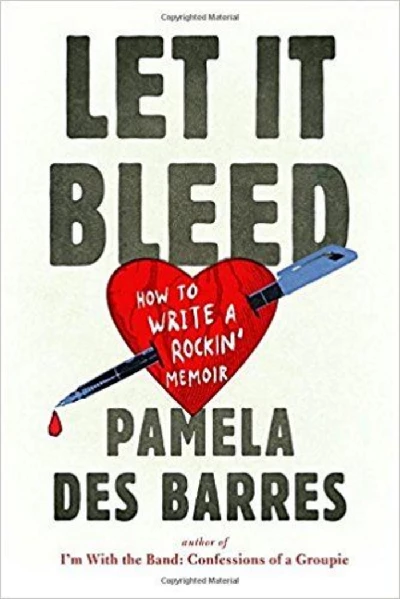published: 16 /
9 /
2017

While in Pamela Des Barres' debut memoir, 'I’m with The Band', she disclosed her groupie secrets, Lisa Torem finds in 'Raging Pages' in her new book 'Let It Bleed: How to Write a Rockin’ Memoir' her sharing her fresh approach to writing the 'femoir'.
Article
In Pamela De Barres’s 'New York Times' bestseller, 'I’m with the Band: Confessions of a Groupie', the journalist, writing teacher and media personality described her colourful dates with Jimmy Page, Mick Jagger, Keith Moon and Jim Morrison. (She is also known for her participation in the all-female rock band, The GTO’s, and for being one of the chief inspirations for the character Penny Lane in the American film, 'Almost Famous').
Ms. Des Barres wrote several more memoirs since that time (for example, 'Take Another Little Piece of My Heart', about the birth of her son), but in her current book, 'Let It Bleed: How to Write a Rockin’ Memoir', she reaches out to her legions of female fans in an effort to teach them how to create their own personally fulfilling “femoir”.
Refreshingly, hers is not just another “how-to” book based on dry or abstract theories; in 'Let It Bleed', Des Barres encourages her “dolls” to write without fear of judgment, and to dig deeply below the surface, sometimes literally and figuratively, as when replying to a prompt such as: “How do you feel about your appearance? Are you vain or insecure?”
Essentially, Des Barres provides a ton of rich prompts, and asks that her readers do what her real-life participants do in her nationally-recognized writing workshops: write a first draft in twelve minutes. She makes it clear that she wants her students to feel empowered and challenged by the various prompts, and there are few themes that she consciously avoids.
That said, the best way to experience this book is to follow the prompts and then compare what one has written with her other “dolls.” But even if one doesn’t undertake this challenge, it’s wonderful to read certain passages that show tremendous emotional and/or psychological growth and the book, for authors especially, is a great tool for gaging emotional depth and growth through creative mastery.
Des Barres admits that many of the themes are difficult to discuss or put to the page but she takes a leadership role by including essays about her own most painful moments. For example, her response to “Did you ever keep any secrets from your parents?” is telling and poignant.
Another prompt, “Have you ever felt like you were on the outside looking in?” is one example, in which a Los Angeles writer speaks her heart about another extremely personal and upsetting experience.
But there are also prompts that encourage more light-hearted memories: “Describe your first car” or “Do you consider yourself to be a funny person?” Des Barres, thankfully, balanced out the prompts, as she would probably be the first to admit that some individuals would get overwhelmed quickly if she had not.
Throughout the chapters, we also gain a clear perspective of her personal and professional background, and how she developed her clever techniques for teaching creative writing over the years. Readers, whether at the beginning stage or already steeped in a writing-related career, will rarely find a more enthusiastic mentor. Des Barres roots with abandon for each “doll” as the chapters’ progress, until she joyfully reassures the reader that she is ready to complete the grueling “femoir” process.
That said, in 'Let It Bleed', Des Barres successfully shares her delightfully unconventional approach to creative writing, which, for over two decades, has yielded a plethora of dynamic, and illuminating content and countless fans. Readers and writers may “bleed,” but they will also rejoice.